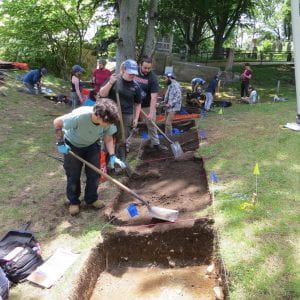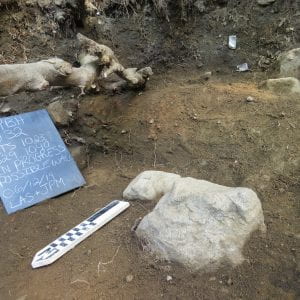Greetings from Plymouth, MA! The excavations on Burial Hill are in full swing, and there is quite a lot happening. Every day the piles of dirt grow, and every day, as the students dig deeper in their excavation units, more artifacts from the 17th, 18th, and 19thcenturies are recovered. Though we’ve had a few set backs from rain days, we have accomplished a lot during our week and a half on the Hill.
The excavation site on Burial Hill is located at the edge of the cemetery on one side, and a crypt dating to the 1830s on the other. Though the slope can be intense, we still have plenty of room for our 24-person crew of students, TAs, Fiske Center faculty, members from the Mashpee Wampanoag, and local volunteers to work.
Broadly speaking, there are two components of the site we are looking into: an intact Native American site (most likely a Wampanoag occupation from the 16thor 17thcentury) on the northern edge of the Hill, and on the south side, a structure dating to the 17thcentury. As we dig, we hope to learn the how large these two areas of interest are and crucially, how they relate to each other in space and time.
Additionally, we are also looking for evidence of the 17thcentury palisade, a barricade that would have enclosed the early settlement. Though we’ve dug in some likely locations for the palisade, we’ve had no luck so far finding any evidence. Now, new units have been opened up that connect the northern half of the site to the southern half, with the hope of showing not only what the soil layering looks like across the hill, but also increased odds that we will find the stains in the soil from the posts of the palisade.
On the northern half, several excavation units have been opened to recover the extent of the Native American site that was excavated in 2016 and 2017, and to see if there is a clear definition between the inside of the Pilgrim settlement, and outside of the settlement. So far, the students have recovered only a few pieces of Native American ceramic and flakes from stone tool making, and very few artifacts that are likely from the colonial period, which seems to support our hunch that as we move towards the structure, we are moving inside the Pilgrim’s settlement. All we need to do is find evidence of the Pilgrim’s palisade and we’re golden!
On the southern end of the site, in the shade of a large copper beech tree, there is evidence of a 17thcentury structure on the southern side. Stains in the soil from last year’s excavation suggest that a building stood on the side of the hill in the mid-17thcentury. This year, the students are not only working in last year’s excavation units to continue digging down to 17thcentury soils, but also expanding the previous seasons’ excavation units to find the extent of this structure. However, most of the artifacts recovered so far from these new units have been from the 19thcentury, but as we dig deeper we are finding more materials from the 17thcentury. Notable finds from these excavations include some beautiful pieces of pottery, a button, and lots of glass, nails, and daub (plaster used for insulation in early houses). These will undergo cleaning and analysis in our labs.
There’s still plenty of more work to be done and only 2 weeks left here in Plymouth. Feel free to come visit us on Burial Hill during the week for daily updates on our progress and to see archaeology in action!
Photo Credits: Christa Beranek





